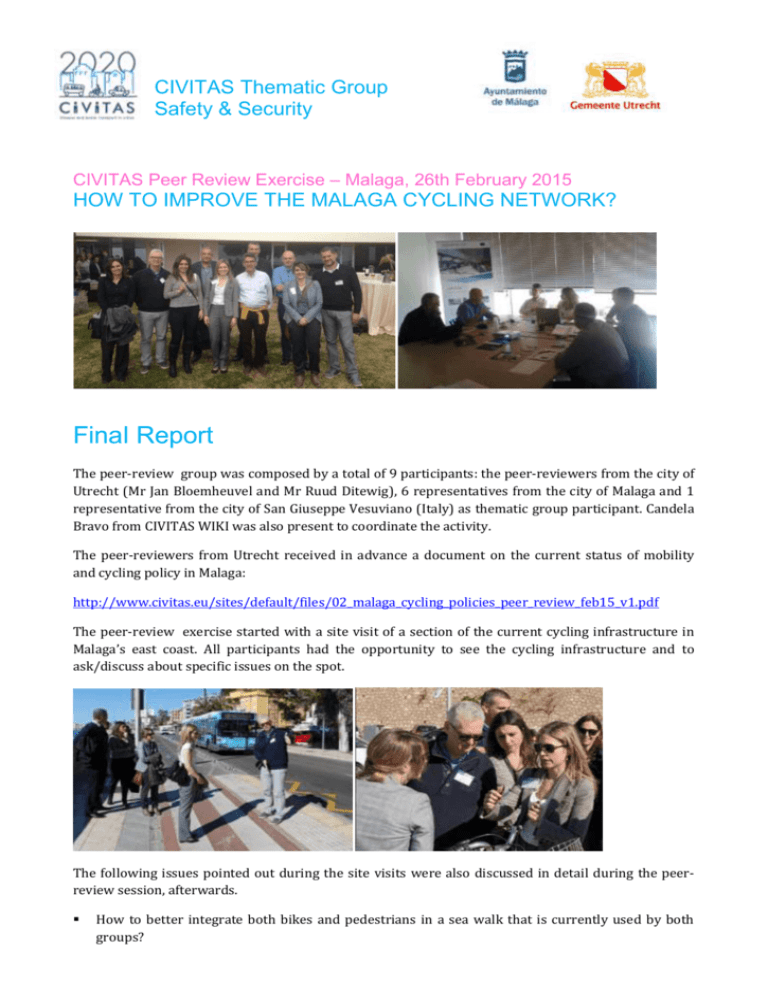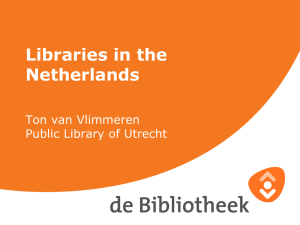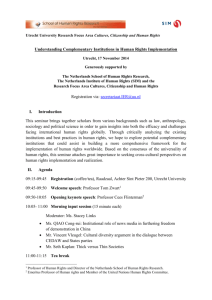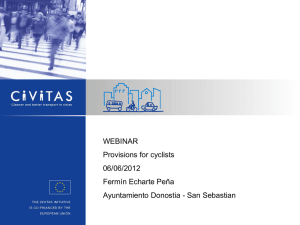CIVITAS WIKI_ Malaga Peer
advertisement

CIVITAS Thematic Group Safety & Security CIVITAS Peer Review Exercise – Malaga, 26th February 2015 HOW TO IMPROVE THE MALAGA CYCLING NETWORK? Final Report The peer-review group was composed by a total of 9 participants: the peer-reviewers from the city of Utrecht (Mr Jan Bloemheuvel and Mr Ruud Ditewig), 6 representatives from the city of Malaga and 1 representative from the city of San Giuseppe Vesuviano (Italy) as thematic group participant. Candela Bravo from CIVITAS WIKI was also present to coordinate the activity. The peer-reviewers from Utrecht received in advance a document on the current status of mobility and cycling policy in Malaga: http://www.civitas.eu/sites/default/files/02_malaga_cycling_policies_peer_review_feb15_v1.pdf The peer-review exercise started with a site visit of a section of the current cycling infrastructure in Malaga’s east coast. All participants had the opportunity to see the cycling infrastructure and to ask/discuss about specific issues on the spot. The following issues pointed out during the site visits were also discussed in detail during the peerreview session, afterwards. How to better integrate both bikes and pedestrians in a sea walk that is currently used by both groups? How to improve the cycling lane in a specific bus stop exit, in order to avoid collisions between bus passengers getting in and out the bus and bikes going through? What methods/materials (best practices) are used in Utrecht for the maintenance and cleaning of cycling paths? What methods/actions are used in Utrecht to avoid vandalism/thefts? After the site visit the participants continued the peer review in the event´s venue. Welcome of participants The session started with round-the-table presentations of each participant. Presentation from City of Malaga Ms Carmen Abad Alejo http://www.civitas.eu/sites/default/files/30_presentation_peer_review_excercise_260215_cyclin g_v2_public.ppt Ms. Carmen Abad Alejo gave a presentation about the “Cycling policies and infrastructures in Malaga”. This part of the session was quite interactive and the peer-reviewers provided feedback, comments and recommendations during the presentation as reported below. Construction Techniques and Materials used in Bicycle Lanes Route design of bicycle lanes and bus stops: The following two situations of bicycle lanes in bus stops were presented (see picture A and B, below). The situation on picture B was visualized during the site visit. Peer-reviewers expressed that picture A was the best solution for this case. Concerning picture B, the peer reviewers recommended to include a type of fence or separation that will prevent collisions of passengers getting off the bus and cyclist in the bicycle lanes. This separation should lead passengers to not enter in the bicycle lane. However, it was also noted that important consideration should be given to disabled passengers, ensuring the fence or separation does not become an obstacle for them. Picture A Traffic lights: Picture B The situation of traffic lights was also discussed (see pictures C and D below) namely how to include traffic lights in the bicycle lanes. The peer reviewers recommended to include a yellow light for bikes and to have traffic lights for bikes and pedestrians in the bike lanes or side walk. Picture C Picture D Construction process: Another topic actively discussed was related to the methods and techniques used for coating/construction of the bike lanes. Some of the issues discuss were: The type of foundation used (asphalt) for the lanes. In Malaga it is used normal foundation (asphalt) and covered with a thin layer of red colour. While in Utrecht it is used red color asphalt but it was pointed out that this material not very strong. Picture E The peer reviewers asked if there were any problems with the covering due to the hot weather during summer in Malaga. Representatives of the city of Malaga explained that there are no major problems because of the hot weather. Furthermore, it was explained that in terms of protection, the bike lanes have between layers a plastic protection sheet to avoid the humidity deteriorates the paint. The time for drying the paint it was also found interesting, in Utrecht the paint is only given when there is good weather and it takes half a day to dry, while in Malaga the paint in a summer day it takes around half an hour to dry. Maintenance: In terms of maintenance, the city of Malaga is implementing a standard cleaning method consisting in a mechanical sweeping that (with time) deteriorates the pavement and the horizontal signing. The peer reviewers explained the method used in Utrecht consist on blowers used by hand which move the dirt to the kerbstone, then a machine without brushes sucks the dirt. Picture F Separators: Regarding the use of separators (see pictures G and H below), the peer reviewers informed that Utrecht does not use separators to differentiate bike lanes from the street, people (commuters, pedestrian and cyclist) are used to use the bike lanes; there is no need for such systems. They suggested that after some years, separator could be removed. In Utrecht the separators are only used to avoid illegal parking. Picture G Picture H Signposting: Malaga is planning to implement signposting of the route (see picture I below), the peer reviewers found this a very good idea. PILLAR DIAGRAM OF THE ITINERARY Picture I Junctions and sensitive spots Junctions: INTERSECTIONS AND ROUNDABOUTS In terms of some situations related to “junctions design”, the peer reviewers considered picture J the best option. Picture J Picture K Sensitive spots: Specific “sensitive spots” for the city of Malaga were also presented and discussed, for instance streets with one-way only for vehicles and two-way for bicycle, and the specific cases presented in pictures L, M and N. Picture L Picture M Picture N Concerning the streets with bus lane and bike lane, the peer-reviewers recommended to always keep both lanes separated as to join them together can be very dangerous. In fact in Utrecht the side-mirrors of large vehicles where improved to avoid accidents with cyclist. Cycling parking facilities (safety and security measures) Vandalism: Vandalism or security are important issues that are difficult to complete eradicate, for instance according to the peer reviewers people in Utrecht use old bikes because of this concerns (i.e. vandalism, thefts, etc.). Some solutions to mitigate these risks are (i) to install (by bike producers) tracking devices in the public bikes. However, due to privacy rights this type of devices are not allowed, although for the city of Malaga this type of information could be very useful to understand cycling behavior patterns, busiest lanes, and most popular bike dropping spots; (ii) to install video cameras in the bike-dropping spots; (iii) to develop guarded parking space. Coexistence between bicycles and pedestrians In order to delimit the bike lane from the pedestrians´ the following badges (see picture O and P) have been developed. According to the peer reviewers these badges might be too small, cyclist will not see them. Picture O Picture P Peer-Reviewers´ presentations: Jan Bloemheuvel – Grant Manager at Utrecht City Council Ruud Ditewig – Senior Bicycle Policy Advisor at Utrecht City Council During the last part of the peer review exercise, a presentation was given by the peer reviewers about the cycling planning of city of Utrecht. http://www.civitas.eu/sites/default/files/utrecht_bicycle_program.pptx http://www.civitas.eu/sites/default/files/malaga_2015_peer_review.pptx The city of Utrecht has a very dense cycling population; around 33% of journeys within the city are made by bicycle. Therefore, Utrecht city council is implementing specific infrastructures and measures to accommodate such a significant cycling community. The presentation moderated by Mr. Jan Bloemheuvel and Mr. Ruud Ditewig included: Several videos where the city of Utrecht and the cycling planning were presented; Information about the development planning of bicycle space parking. Currently there is parking space with capacity for 4300 bikes, in 2015 it is foreseen to open the world's largest bicycle parking station, near the Central Railway Station, with a capacity for 12.500 bikes and for the medium to long term the city of Utrecht envisaged constructing additional parking space with capacity for 33.000 bikes; The city of Utrecht is also using empty shops from the city center as parking spaces for bicycles. The employers from those parking are people from social programmes or unemployed; All new buildings constructed in Utrecht are obliged to include parking space for bikes. The peer-review exercise was also part of the international seminar on Cycling Policies, in the framework of the CIVITAS 2MOVE2 annual project meeting and the CIVINET Spain and Portugal Annual Forum. Here below the links to the public presentations: http://www.civitas.eu/sites/default/files/malaga_cycling_policies_isabel_gamez.pdf http://www.civitas.eu/sites/default/files/utrecht_jan_bloemhevuel.pdf http://www.civitas.eu/sites/default/files/utrecht_ruud_ditewig.pdf Join the Group @ http://www.civitas.eu/TG/safety-and-security To join the Thematic Group you'll need to Log in first or create an account at http://civitas.eu/user/login and then click on "Subscribe to the Group" in the group page. Comment on CIVITAS Interactive @ http://www.civitas.eu/thematic-cooperation or on the CIVITAS LinkedIn Group @ http://lnkd.in/d44GNU








